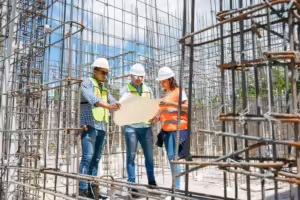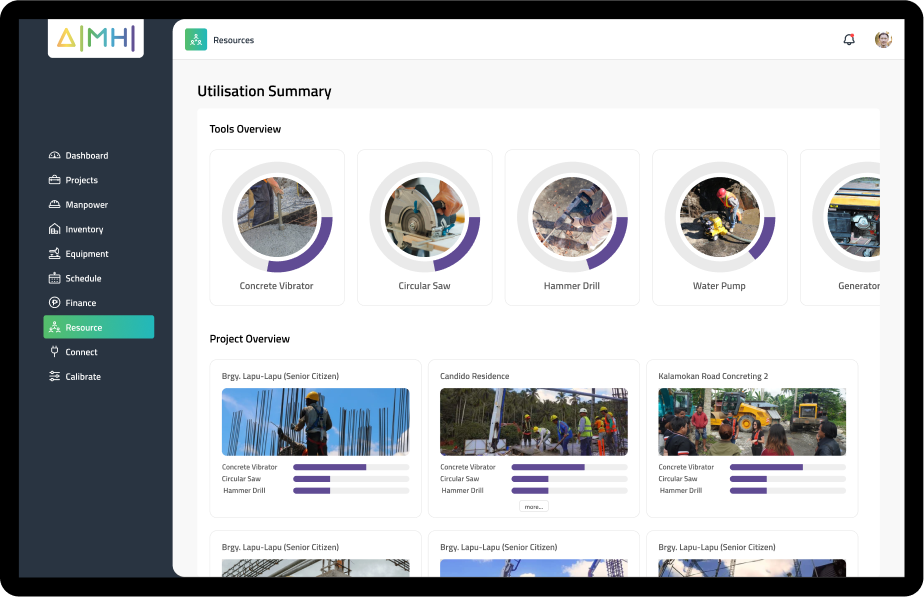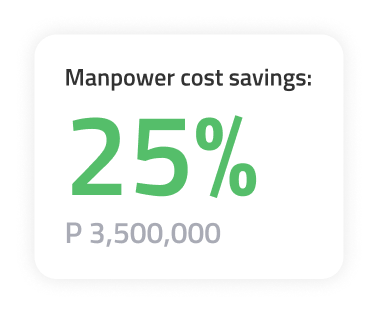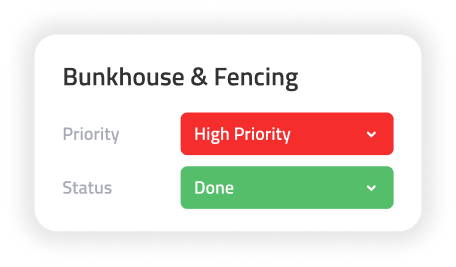Completing projects on time is a constant challenge in the dynamic construction landscape. Many factors play a role in bridging the gap between timely project completion and unexpected delays. From intricate project planning and resource allocation to project design and construction, these critical phases demand a strategic approach.
When time is of the essence, it’s important to find the right balance between efficient construction workflow and quality. Here’s when construction project management comes into the picture.
Generally, 70% of projects fail, but implementing project management solutions has proven beneficial. According to WebinarCare 2023 statistics, 45% of organizations enjoy almost all of the intended benefits of having project management tools. To navigate the complexities of construction project management in 2024, we’ll discuss actionable insights to help you achieve timely project completion without succumbing to the pressures of extended work hours.
Below, we’ve tailored strategies to empower you with the latest techniques, trends, and tools so projects are delivered on schedule, preserving a healthy work-life balance.
The Foundation: Effective Project Planning
In the construction business, it’s essential to have a well-defined project plan showing the timeline of project completion. It helps everyone involved know what needs to happen and when so the project stays on track and gets done on time.
The incorporation of project management tools and software such as AIMHI stands as a pivotal strategy to ensure the timely completion of projects. These tools play a crucial role in enhancing project management efficiency by providing a structured framework for tasks, such as:
✓ Organizing tasks and schedules
✓ Meeting construction project deadlines
✓ Allocating resources
Employing such advanced technology fosters improved communication and collaboration among project stakeholders and streamlined workflow. Moreover, these tools offer valuable insights and analytics, enabling proactive identification of potential construction issues such as delays.
| “Being on time, within budget, and of utmost quality are the aspects that make a well-accomplished project, which I, as a Site Engineer, must follow through. AIMHI is the support platform that reinforces me to achieve these. Through AIMHI, I can overview where and when I can provide engineering interventions to yield cost optimization and mitigate delays. Feron Jay Juan, Site Engineer |
In essence, the judicious utilization of management software solutions emerges as an indispensable facet in the meticulous process of construction projects.
Here are some reasons why.
Leverage Artificial Technology to Minimize Manual Tasks
Manual roles and tasks traditionally consume significant time and resources. They are also costly. Repetitive tasks are one of the reasons why decision-makers consider options for implementing digital solutions.
AI solutions help automate various project management processes, ranging from scheduling and resource allocation to communication and data analysis. By automating routine tasks, such as updating project timelines or generating progress reports, construction professionals can redirect their focus toward more strategic and value-added aspects of project oversight.
This solution not only enhances efficiency but also reduces the risk of errors associated with manual data entry, contributing to a smoother and more accurate project execution. Besides productivity, it also improves competitiveness in the construction market and industry.
Enhanced Collaboration and Communication
AIMHI as an AI management software serves as a centralized hub that facilitates enhanced collaboration and communication among project stakeholders. With real-time updates and a centralized platform for sharing documents and information, team members can seamlessly collaborate regardless of their physical location.
| We are fortunate to have multiple projects in different areas. However, given the location of each site, physical monitoring of the site presents a significant challenge. Luckily, our technology is constantly evolving and thanks to AIMHI, our engineers can easily upload site data such as their site visit checklist, photos, equipment, and fuel consumption. And, as with my team, we can download this data immediately and use it to analyze whether specific projects need to improve the achievements of their site or adjust project expenses.” Zandre Ann Limoran, Planning Department Head, Metro Gear Construction Corporation |
Moreover, your construction business can enjoy the following benefits:
- integrated and transparent working environment
- easy access to up-to-date information
- allows everyone participation to discussions and stay informed about critical developments
- accelerates decision-making processes and minimizes the likelihood of information gaps that can cause delays
The secret to delivering construction projects on time and on a budget does not end here. Ultimately, you can achieve informed decision-making which is vital in effective project management.
Data-driven Decision-making and Insights
One of the significant advantages of management software in construction is its ability to generate valuable data insights. These insights are derived from the analysis of project performance, resource utilization, and various other metrics. By leveraging this data, project managers can make informed decisions, identify potential bottlenecks before they escalate, and implement proactive strategies to mitigate risks.
The data-driven approach also enables continuous improvement, as lessons learned from one project can be applied to enhance processes in subsequent endeavors. In this way, management software not only aids in meeting project deadlines but also contributes to the long-term success and efficiency of construction operations.
Continue reading below for more project scheduling tips and time-saving construction techniques to effectively complete projects without working more.
Tip #1: Set Realistic and Achievable Project Goals
Setting SMART goals is a critical component in the successful management of construction projects.
Specific, Measurable, Achievable, Relevant, and Time-Bound.
The process involves breaking down the overarching project into smaller, manageable tasks, each with its own set of objectives and deadlines. By doing so, project managers can create a roadmap that not only guides the team but also allows for systematic progress tracking at various stages.
These milestones serve as measurable indicators of project advancement, helping to identify potential challenges early on. They instill a sense of accomplishment as they are reached and boost team morale and motivation. Moreover, they provide a structured framework for resource optimization and task prioritization, ensuring that the project stays on course without unnecessary delays.
Tip #2: Scheduling Projects in Detail
A detailed project schedule involves assigning specific timelines to each task, allowing for a comprehensive overview of the project’s trajectory. AIMHI as a project management software becomes particularly beneficial in this context.
AIMHI facilitates the seamless organization and tracking of project schedules. By adhering to a well-crafted schedule, construction teams can proactively manage their time, allocate resources, and minimize the likelihood of unexpected setbacks.
Advanced construction methods have proven instrumental in accelerating project timelines as early as the 80s. Automated systems back then allowed project construction to commence when 40 percent of the project’s design was completed rather than 100%.
Tip #3: Implementing Lean Construction Principles
One strategic approach that further enhances timely project completion is identifying and eventually eliminating non-value-adding activities. These activities refer to tasks or processes that do not contribute directly to the end product, customer satisfaction, or overall project success. Some common examples include the following:
- Unnecessary movement of materials or equipment without contributing to the construction process
- Producing more than what is immediately needed, leading to excess inventory and storage costs
- Delays and idle time, whether due to equipment breakdowns, unavailability of materials, or scheduling issues
- Fixing errors and defects in completed work or reworking due to poor planning and execution
- Failing to utilize the full range of skills and expertise within the construction team
- Poor communication, including unnecessary meetings, unclear instructions, or redundant paperwork
- Excessive paperwork, approvals, or administrative tasks that do not contribute directly to project progress
Identifying and eliminating these non-value-adding processes promptly is crucial for enhancing efficiency, reducing waste, and ultimately completing construction projects on time without unnecessary effort.
Final Thoughts
While the strategies outlined in this guide are geared towards achieving timely construction project completion, it’s paramount to underscore the profound importance of maintaining a healthy work-life balance within the construction industry. The relentless demands and high-pressure environment often associated with construction projects can take a toll on the well-being of the professionals involved. Recognizing the significance of work-life balance not only enhances the overall quality of life for individuals but also contributes to sustained productivity and creativity in the workplace.
AIMHI smart solutions not only contribute to the practical aspects of work-life balance but also signify a commitment to adapting to the changing needs of the workforce. Embracing technology fosters efficiency in project management and reflects an industry-wide dedication to creating an environment where professionals can thrive both personally and professionally.
As we navigate the future of construction, the integration of AI solutions becomes not just a necessity for project success but a testament to the industry’s commitment to the holistic well-being of its workforce—a workforce that is equipped to face challenges with resilience and innovation while maintaining a sustainable work-life balance.









